Subjects:
- Preface
- Inverter
- Regenerative braking
Preface:
Electric motors in vehicles with fully electric or hybrid drive work with alternating current (AC). The energy for the electric motor does not come directly from the battery, as it only supplies direct voltage (DC). The DC voltage from the battery is fed into the reverse converted to an alternating voltage for the electric motor.
In addition, we find Converters that turn a low DC voltage into a higher voltage (boost converter). The battery voltage can be “boosted” up for the electric motor (650 volts), or lowered to charge the on-board battery battery (14 volts). The converter is also used to switch from a high voltage to a low voltage, for example to supply the interior accessories with a voltage of 12 or 24 volts (passenger or heavy commercial vehicles). Click here for the page about the converter.
The following image is of a Tesla Model S: the interior of the inverter and an overview of the so-called “drive unit” where the inverter, transmission and electric motor are located in a joint unit at the rear suspension.
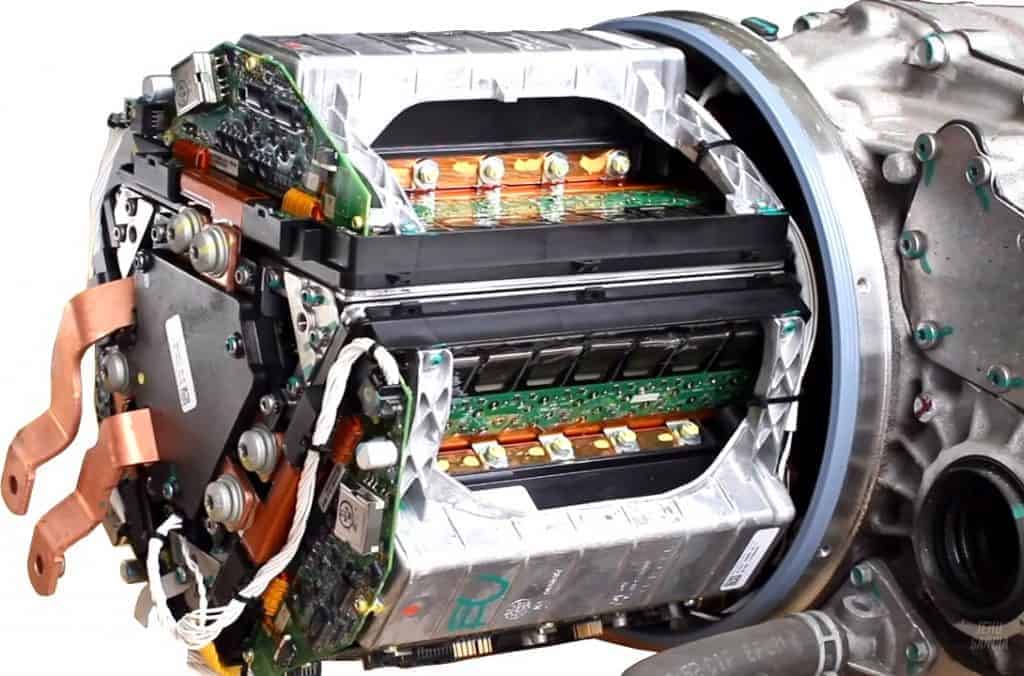
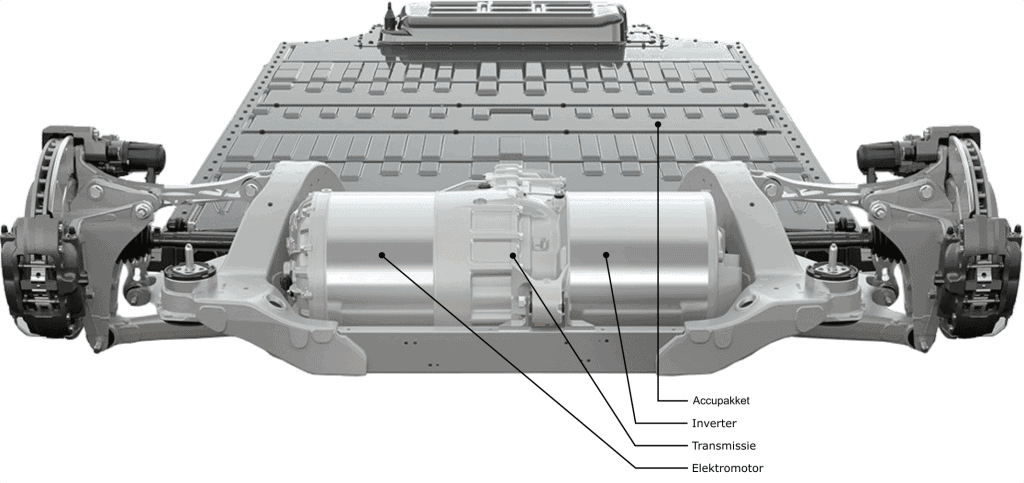
Inverter:
The image in the paragraph “Boost converter” shows the overview with the boost converter, the inverter with twelve IGBTs and two electric motors (MG1 and MG2).
The bottom seven diagrams show the control of the transistors and the current direction to and from the stator coils. The boost converter and the IGBTs + MG2 are omitted for convenience. We see it on the left in the diagram HV battery pack; this is the high-voltage battery in which a voltage of approximately 200 to 800 volts is stored. To the right of the battery we see a capacitor. When the HV system is activated, the HV protection system initially regulates a limited current from the HV battery pack by means of a resistor. This is done to slowly charge the capacitor before the HV system becomes fully operational.
In addition, we see six high-power transistors. These are the IGBTs that control the electric motor. The IGBTs are controlled by the control unit; this is indicated as “IGBT driver”. On the right we see the stator with three coils (U, V and W) colored blue and red. In the center of the stator is the rotor that is set in motion by magnetism, see the paragraph about the electric motor.
The upper transistors (T1, T3 and T5) switch the positive connections from the HV battery to the stator coils when the transistors are turned on by the control unit. The lower transistors (T2, T4 and T6) conduct the masses to the negative of the high voltage battery.
The gate terminals of the IGBTs currently being driven are shown in green. With a synchronous motor, the control unit “reads” the position of the rotor position sensor to determine which IGBT to control. The rotor position sensor is also known as a resolver .
1. Currently controlled IGBTs:
- T1: plus (100% controlled);
- T2: mass (50% controlled);
- T6: ground (50% controlled).
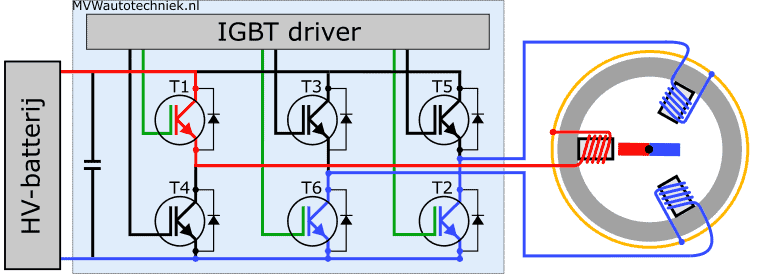
2. Currently controlled IGBTs:
- T1: plus (50% controlled);
- T3: plus (50% controlled);
- T2: ground (100% controlled).
The rotor rotates due to the changed magnetic field.
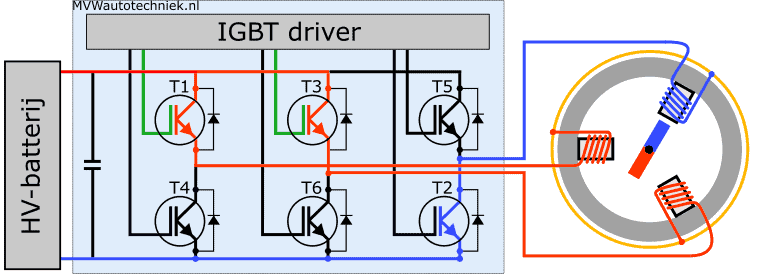
3. Currently controlled IGBTs:
- T3: plus (100% controlled);
- T2: mass (50% controlled);
- T4: ground (50% controlled).
The rotor rotates due to the changed magnetic field.
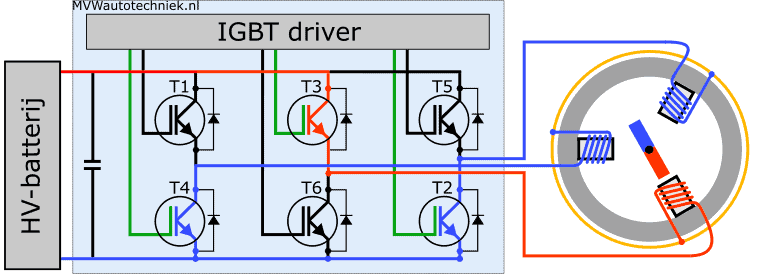
4. Currently controlled IGBTs:
- T3: plus (50% controlled);
- T5: plus (50% controlled);
- T4: ground (100% controlled).
The rotor rotates due to the changed magnetic field.
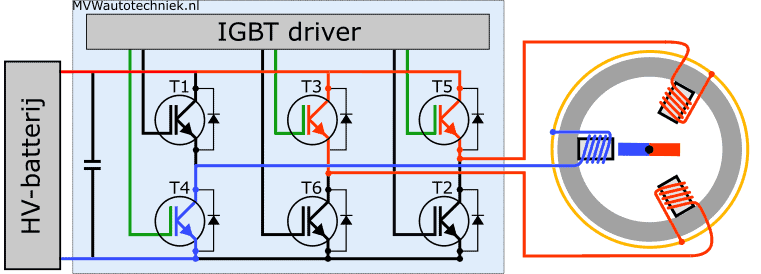
5. Currently controlled IGBTs:
- T5: plus (100% controlled);
- T4: mass (50% controlled);
- T6: ground (50% controlled).
The rotor rotates due to the changed magnetic field.
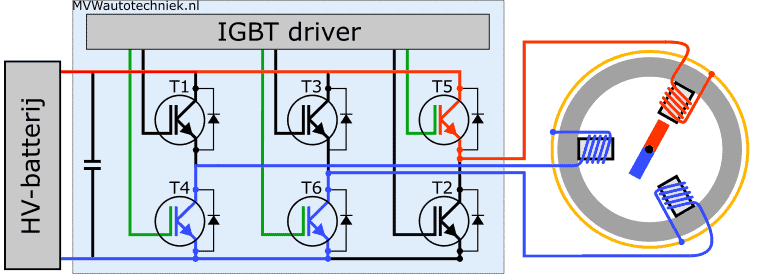
6. Currently controlled IGBTs:
- T1: plus (50% controlled);
- T5: plus (50% controlled);
- T6: ground (100% controlled).
The rotor rotates due to the changed magnetic field.
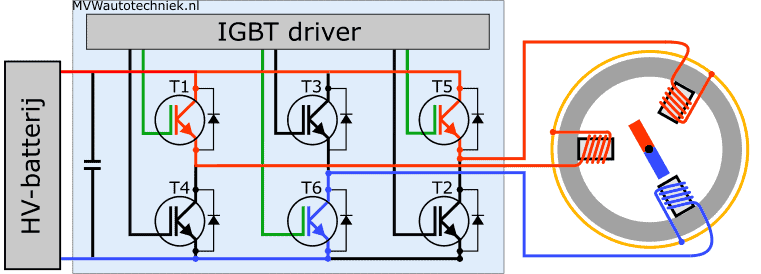
7. Currently controlled IGBTs:
- T1: plus (100% controlled);
- T2: mass (50% controlled);
- T6: ground (50% controlled).
The rotor has now rotated 360 degrees (1 full rotation) from the situation in situation 1. The cycle with transistor circuits is repeated again.

The inverter converts the DC voltage from the HV battery into a 1-phase sinusoidal AC voltage. The three images below show:
- Left: loading the coil;
- Middle: unloading the coil;
- Right: coil charge and discharge curve.
We achieve the charging and discharging of the coil by driving the base of the transistor with a square-wave voltage. When the coil is discharged, the magnetic field falls and the induced voltage creates a short-term induced current. The extinguishing diode causes the coil to discharge.

The 1-phase sine wave is obtained by changing the duty cycle at which the transistor becomes conductive. The following text is about the images below.
- Left: at this frequency the coil cannot charge sufficiently and an average voltage is created;
- Right: The duty cycle is adjusted by the IGBT controller. The charge and discharge time determine the level of current through the coil.
The IGBTs in the inverter are continuously switched on and off. The relationship between switching on and off takes place according to a PWM control. The wider the pulses (higher duty cycle), the greater the current that flows through the coil and thus the more powerful the electric motor. The average current is indicated by the black sine wave. The following figure shows three sinusoidal drive signals:
- Blue: high drive. The duty cycle is high. The current becomes maximum.
- Green: medium control. The duty-cycle percentage is lower than with the high control. The current is therefore lower.
- Red: low drive. The duty cycle percentage has again decreased. The current is halved compared to the maximum control.
The sine is positive for half a period and negative for the other half. The IGBTs in the DC-AC inverter are switched in such a way that a direct voltage (DC) is converted into an alternating voltage (AC). The direction of current through the stator coils is periodically reversed.
by increasing the number of sine shapes per unit time, the rotor speed increases.
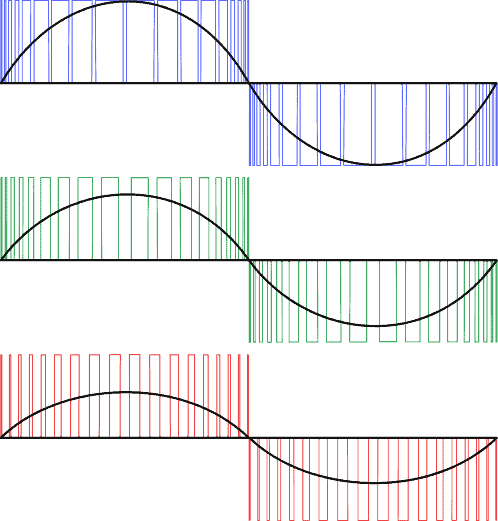
The following animation shows the inverter control. Below the inverter you can see the time course of three phases. The rotor rotates two full revolutions (360 degrees) in the animation. Each rotation is divided into six time units (1 to 6). Below that you see colored bars:
- Dark blue: T1
- Green: T2
- Light blue: T3
- Orange: T4
- Pink: T5
- Red: T6
We focus on the first half revolution of the course of time:
- From 0 to 180 degrees, the rotor rotates half a revolution. During this period, IGBT T1 is controlled.
- Between 0 and 60 degrees, in addition to T1, T5 and T6 were also active.
- T1 switches the plus, T5 and T6 ground. Each transistor had its own duty cycle, varying between 50 and 100%.
- At 60 degrees, T2 takes over from T5: the direction of current in the coil is reversed.
- At that moment there is alternating voltage: because the current direction has changed, the current strength is negative.
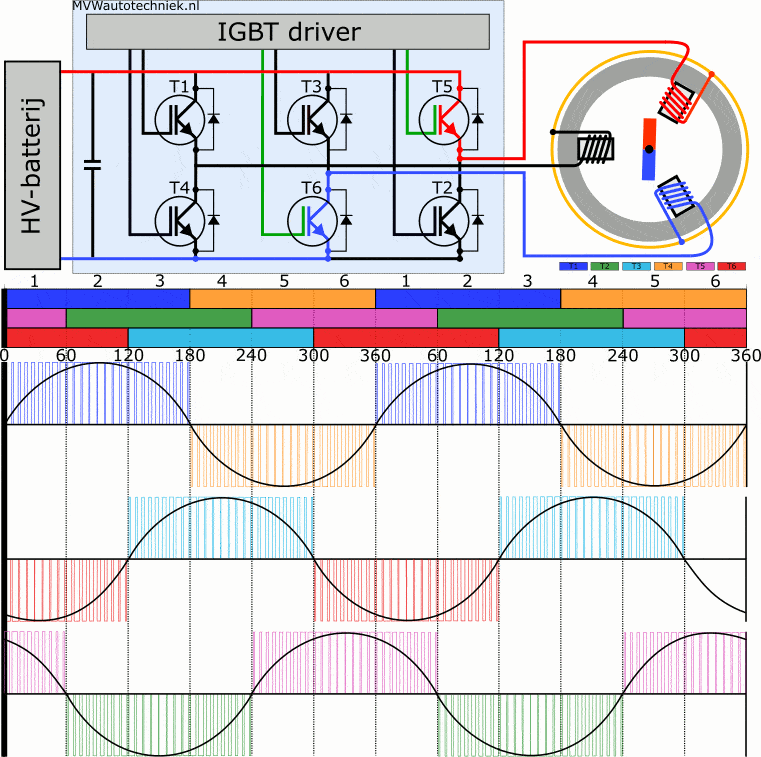
To control the correct coils in the AC synchronous electric motor with the inverter, the inverter looks at the signal from the resolver. The resolver registers the position of the rotor both when stationary and during rotation.
Regenerative braking:
When braking on the engine, the electric motor is used as a generator (dynamo). The kinetic energy of the vehicle is converted into electrical energy: the battery is charged.
The IGBTs are switched off during regenerative braking: the driver does not control them. The rectifier diodes between the source and drain of the IGBTs act as a rectifier to convert the AC voltage from the motor into DC voltage for the battery.
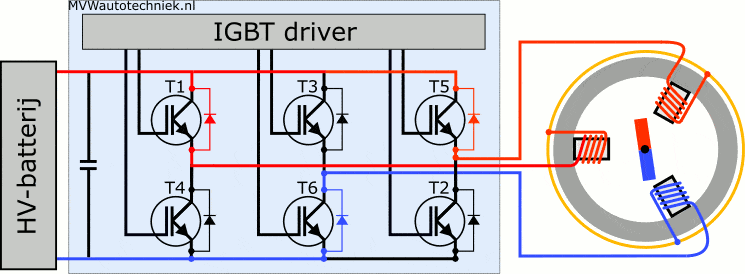
Fully electric and hybrid vehicles, in addition to the option of electric braking, also have a conventional, hydraulic braking system to brake with the brake pads and brake discs. The different techniques and control principles can be found on the page: braking of electric vehicles.
